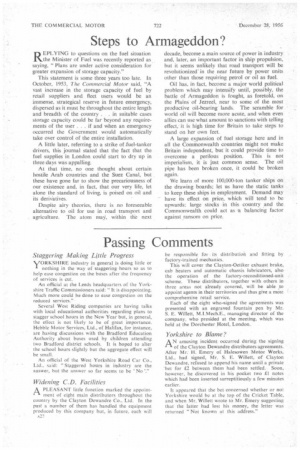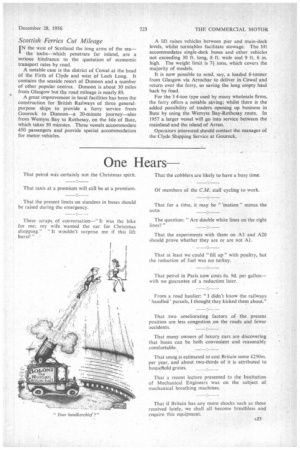Passing Comments
Page 24

Page 25

If you've noticed an error in this article please click here to report it so we can fix it.
Staggering Making Little Progress
VORKSH IRE industry in general is doing little or I nothing in the way of staggering hours so as to help ease congestion on the buses after the frequency of services is cut.
An official at the Leeds headquarters of the Yorkshire Traffic Commissioners said: " It is disappointing. Much more could he done to ease congestion on the reduced services."
Several West Riding companies arc having talks with local educational authorities regarding plans to stagger school hours in the New Year but, in general, the effect is not likely to be of great importance. Hebble Motor Services, Ltd., of Halifax, for instance, are having discussions with the Bradford Education Authority about buses used by children attending two Bradford district schools. It is hoped to alter the school hours slightly but the aggregate effect will be small.
An official of the West Yorkshire Road Car Co., Ltd... said: "Staggered hours in industry are the answer, but the answer so far seems to be 'No
Widening C. D. Facilities
A PLEASANT little function marked the appoint
ment of eight main distributors throughout the country by the Clayton Dewandre Co,, Ltd. In the past a number of them has handled the equipment produced by this company but, in future, each will be responsible for . its distribulio6 and fitting by factory-trained mechanics.
This will cover the Clayton-Oetiker exhaust brake, cab heaters and automatic chassis lubricators, also the operation of the factory-reconditioned-unit scheme. These distributors, together with others in three areas not already covered, will be able to appoint agents in their territories and thus give a most comprehensive retail service.
Each of the eight who•signed the agreements was presented with an engraved fountain pen by Mr. S. E. Willett. M.I.Mech.E., managing director of the company. who presided at the meeting. which was held at the Dorchester Hotel. London.
Yorkshire to Blame?
A N amusing incident occurred during the signing of the Clayton Dewandre distributors agreements. After Mr. H. Emery of Halesowen Motor Works, Ltd., had signed, Mr. S. E. Willett, of Clayton Dewandre, refused to append his name until a private -bet for £2 between them had been settled. Soon, however, he discovered in his pocket two £1 notes which had been inserted surreptitiously a few minutes earlier.
It appeared that the bet concerned whether or not Yorkshire would be at the top of the Cricket Table, and when Mr. Willett wrote to Mr. Emery suggesting that the latter had lost his money, the letter was returned "Not known at this address."
Scottish Ferries Cut Mileage
IN the west of Scotland the long arms of the sea' the lochs—which penetrate far inland, are a serious hindrance to the quotation of economic transport rates by road.
A notable case is the district of Cowal at the head of the Firth of Clyde and west of Loch Long. It contains the seaside resort of Dunoon and a number of other popular centres. Duncan is about 30 miles from Glasgow but the road mileage is nearly 80.
A great improvement in local facilities has been the construction for British Railways of three generalpurpose ships to provide a ferry service from Gourock to Duncan—a 20-minute journey—also from Wemyss Bay to Rothesay, on the Isle of Bute, which takes 30 minutes. These vessels accommodate 450 passengers and provide special accommodation for motor vehicles. A lift raises vehicles between pier and main-deck levels, whilst turntables facilitate stowage. The lift accommodates single-deck buses and other vehicles not exceeding 30 ft. long, 8 ft. wide and 9 ft. 6 in. high. The weight limit is 7+ tons, which covers the majority of models.
It is now possible to send, say, a loaded 6-tanner from Glasgow via Arrochar to deliver in Cowal and return over the ferry, so saving the long empty haul back by toad.
For the 3 4-ton type used by many wholesale firms, the ferry offers a notable saving; whilst there is the added possibility of traders opening up business in Bute by using the Wemyss Bay-Rothesay route. In 1957 a larger vessel will go into service between the mainland and the island of Arran.
Operators interested should contact the manager of the Clyde Shipping Service at Gourock.




















































































